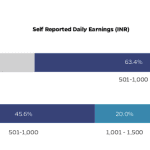Building Back Boldly: How Decisive Government Action Can Support Entrepreneurship in a Post-COVID-19 Economy
COVID-19 has dealt a blow to fast-growing economies worldwide and has threatened the meaningful advances in combating poverty seen in emerging markets in recent decades. We experienced a global economic contraction of 3.5% last year, with the slump more severe in the poorest countries. For comparison, in 2009, at the height of the global financial crisis, emerging markets still grew by 2.6%. Approximately 120 million individuals fell back into extreme poverty (defined as living on less than $1.90 a day) in 2020 as a result of COVID-19, causing adverse effects on their education, nutrition and health.
But as vaccine access gradually increases, things are slowly beginning to look up. As a post-coronavirus economy comes tentatively into view, governments around the world are beginning to outline their economic recovery plans to match vaccine deployment timetables. Coronavirus has also reaffirmed the central role of government in funding not just emergency response but also innovation. The delivery of the Pfizer and Moderna COVID-19 vaccines in record time should debunk, at long last, the idea that innovation is led by the private sector alone. The vaccines have relied on government-funded research as the basic ingredient in their success, helped along by at least $20 billion invested in vaccine producers since March 2020.
Central governments will also play an integral role in the post-coronavirus recovery we all hope to see in the coming months and years. Newly empowered by the role business and government partnerships have played in the pandemic response to date, emerging market governments are likely to deploy entrepreneurship as an economic development tool in the recovery phase as well. Having worked on entrepreneurship support programs for East African governments in our capacity as researchers at MIT, we know this is an opportune moment to leverage this particular tool for economic development. COVID-19 has reordered the way many existing companies do business, and crises like this are critical grist for the creative entrepreneurial spirit, creating room for new players to take hold. The pandemic’s disruption demands large-scale investment to address the risk of long-term economic damage, just as it presents an opportunity for innovative companies to grow in an economy re-shaped by the crisis.
The Impacts of Government Efforts to Support Entrepreneurship
Government has a long history of providing supportive infrastructure to allow entrepreneurs to flourish. One of the best examples of this type of infrastructure is Israel’s Yozma program. Between 1993 and 1998 the Israeli government invested $100 million in 153 companies through partnerships with 10 venture funds. The venture funds retained decision-making power and used the government funding to de-risk investments in novel areas. This injection of capital and risk-sharing helped support growth in the Information-technology industry, which expanded from $1.6 billion to $12.5 billion. The cash was paired with technical and policy support to allow entrepreneurs to do their best work. The program provided government-sponsored accelerators and a nationwide educational agenda focused on STEM, and even fostered international ties with other countries around specific commercial partnerships and goals.
The outcome of this growing entrepreneurship ecosystem in Israel is clear: The country now has a rich startup economy and a flow of large multinationals investing to set up innovation and R&D shops. This multinational investment is rarely the source of the best new ideas in an entrepreneurial ecosystem, but it has tremendous multiplier effects on the overall economy. It brings in new investment, consumer spending — and most importantly, experienced managers who train up more junior employees and upskill a generation of talented individuals. Information technology revenues’ contribution to Israel’s GDP skyrocketed in this period, growing from $1.6 billion annually to $12.5 billion between 1991 and 2000.
Israel is just one example of the success governments can have in boosting their local entrepreneurship ecosystems for development. For instance, in Chile, the government launched “Startup Chile” in 2010, which directly invested in startups that went on to raise US $997 million in capital, over 18 times the government’s investment in the program. Startup Chile attracted foreign investment, prioritized female entrepreneurs and focused on early-stage, hard-to-fund companies.
Accelerating Entrepreneurial Ecosystems with Risk-Tolerant Capital
A critical tool that governments can use to accelerate entrepreneurial ecosystems is risk-tolerant capital. But offering this financing poses a “Goldilocks” problem for a government funder: It’s important to do neither too little nor too much. The challenge a government faces is how to not just funnel money into the economy, but how to get smart money to the right places, so that the funding reinforces existing players, such as incubators, while addressing market failures and encouraging inclusive innovation that addresses the needs of the least-served. Above all, government programs focused on boosting local entrepreneurial ecosystems must make sure they do not “crowd out” private investment. In our work in impact investing, we’ve observed innumerable transactions that a private investor would have made — if they hadn’t been beaten to the punch by a public investor with a more attractive returns structure. This often leads private investors to conclude that investing in a particular country or social sector is too challenging, reducing the availability of private capital.
To avoid this issue, there are three approaches a government can pursue in terms of financing, which should be chosen based on the government’s goals, the maturity of the investor class available in-country, and the stage of the businesses the program will target.
- The government can work as a sole, direct investor with a review committee of industry experts, offering grants for prototyping and business plan development. This works well when the risk is too great for for-profit funders to enter the market. Government seed funding of vaccine development, the internet and many clean technologies are good examples of this approach. This is often most appropriate for companies in the development or early stages of the business lifecycle.
- The government can invest alongside a private investor, as Israel did in the Yozma program, making matching funds available to a private investor to supplement their loan or equity investment into a business. In this case, the government retains the rights to a portion of the returns, but often gives the investor a greater share to reflect the differential effort the investor has made to source and complete due diligence for the deal. This is most appropriate for businesses in the early and expansion stages of the lifecycle.
- The government can mitigate risk for private investors by offering a first-loss guarantee or insuring losses up to a limited amount. This is also most appropriate for businesses in the early and expansion stages of the lifecycle.
The Need for an Ecosystem-Wide Approach
There are no cookie-cutter solutions for designing effective entrepreneurship development programs. Each country has unique market forces and macroeconomic conditions. For example, Israel’s work with Yozma succeeded in part because it coincided with a wave of STEM-educated immigrants from the former U.S.S.R. who flooded the market with their talents in the 1990s. Similar efforts and funds directed at the tech sector in a country without that human capital would have fallen flat.
To do this right, governments must assess the entire entrepreneurial ecosystem and understand what is missing — and what types of interventions could help. Driving investment dollars is just one component of a successful entrepreneurial ecosystem that governments can aim to build as part of their post-COVID-19 recovery. Economies must also ensure that a supportive infrastructure is in place for the companies that do receive investment to thrive. These infrastructure building blocks include: policy that establishes a supportive regulatory and legal environment, human capital to fuel the businesses, finance to fund them, support systems such as incubators, a broader culture that prioritizes entrepreneurship, and markets that provide sufficient demand for end products.
We all hope to see an end of COVID-19 in 2021 and 2022, which will allow us to head gradually back toward a “new normal.” This transition will create opportunities for innovators and investors looking to test out new ideas and deploy pent-up capital. The critical question for governments whose economies have been badly battered by the pandemic recession is whether they can be bold enough to design programs to take advantage of this moment.
Kate Collins consults for impact investors and nonprofits working in climate change and global development; Bar Pereg is a strategy consultant, focusing on purpose-driven growth, financial inclusion and public-private partnership to drive inclusive prosperity in the U.S. and globally.
Photo by Field Engineer from Pexels.
- Categories
- Coronavirus, Investing





